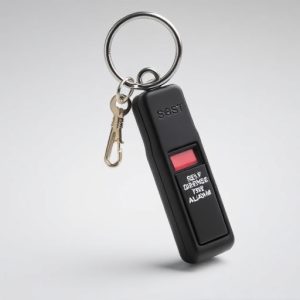Modernizing Law Enforcement: The Integration of Self-Defense Alarm Keychains and Advanced Tech
The modern law enforcement kit now includes a sophisticated blend of advanced tech and traditional …….
The modern law enforcement kit now includes a sophisticated blend of advanced tech and traditional tools, focusing on officer safety and operational effectiveness. A notable addition to this kit is the self-defense alarm keychain, an indispensable tool for personal protection seamlessly adapted into officers' everyday carry (EDC). This compact and discreet device can be activated with a pull or button press to emit a loud alarm, acting as a deterrent against threats or signaling for assistance. Its long-lasting battery and built-in LED light ensure visibility in low-light conditions. The keychain complements other defense tools by providing an immediate, non-lethal response option that can help de-escalate situations or call for backup. It underscores the progression of law enforcement equipment, reflecting its integral role in contemporary public safety initiatives. Recent advancements have also seen the integration of body cameras and advanced communication systems into standard police gear, enhancing situational awareness, secure data sharing, and recording of interactions. The self-defense alarm keychain exemplifies this shift towards technology that not only protects officers but also contributes to proactive policing and intelligence gathering, paving the way for predictive policing models and elevating operational efficiency. As technology continues to advance, we can expect further integration of high-tech systems into police gear, further bolstering personal safety and enhancing law enforcement strategies.
In an era where law enforcement officers face increasingly complex challenges, the equipage they carry is evolving to meet the demands of modern policing. This article delves into the critical components that constitute the arsenal of a contemporary officer, emphasizing the integration of advanced technology and innovative personal security devices. Among these, the self-defense alarm keychain emerges as a versatile tool for both officers’ safety and community protection. We will explore the role of these alarms within the broader context of law enforcement gear, examining their features and benefits, as well as the evolution of non-lethal defense tools, durability in protective gear, and the significance of communication and surveillance technology. Additionally, we will discuss the importance of proper training and maintenance to ensure these devices operate at peak performance and comply with stringent safety standards and regulations. Join us as we navigate the intersection of technology, security, and the ever-adapting landscape of law enforcement equipment.
Essential Components of Modern Law Enforcement Gear with a Focus on Self-Defense Alarm Keychains
Modern law enforcement gear is a complex assembly of technology and traditional equipment, all designed to protect officers and facilitate their duties effectively. A critical component within this ensemble is the self-defense alarm keychain, an innovation that has become indispensable in the field. These alarms serve as a deterrent against potential threats, emitting a loud audible sound that can disorient an assailant or draw attention to an officer in distress. The design of these keychains is compact and unassuming, allowing officers to carry them seamlessly as part of their everyday carry (EDC). They are typically activated by a quick tug or press of a button, ensuring a swift response when seconds count. The self-defense alarm keychain operates on a long-lasting battery, and some models feature a built-in LED light for visibility in low-light conditions. This tool complements other defensive gear such as batons, pepper spray, and firearms by providing a non-lethal, immediate option to de-escalate confrontations or signal for help in emergencies. The integration of this self-defense mechanism into law enforcement gear underscores its importance as a modern tool for personal safety and public service.
The Role of Advanced Technology in Contemporary Police Equipment and Personal Security Devices
The integration of advanced technology into law enforcement gear has significantly enhanced the capabilities of officers for personal security and situational awareness. Modern police equipment now routinely includes a range of cutting-edge devices, from body cameras that record interactions with the public to advanced communication systems that enable secure and efficient information sharing among personnel. One of the most notable technological advancements in this sphere is the adoption of personal security devices such as self-defense alarms integrated into keychains. These compact yet effective tools provide officers with a non-lethal means to deter threats, emit disorienting sounds capable of deterring potential assailants, and offer an additional layer of protection during lone patrols or high-risk situations. The self defense alarm keychain serves as a testament to the growing emphasis on empowering law enforcement with technology that prioritizes both officer safety and public security. These devices are designed to be user-friendly, ensuring that officers can rely on them instinctively when needed. Moreover, they often come equipped with features like LED lights for visibility and built-in strobe capabilities to disorient an attacker, making them indispensable in a variety of scenarios where immediate personal defense is required. The role of such technology is not limited to direct confrontations; it also extends to the strategic planning and intelligence gathering stages, where data analysis and predictive policing models contribute to proactive law enforcement strategies. As technology continues to evolve, the potential for further integrating advanced systems into police equipment remains vast, promising even greater enhancements in personal security and operational efficiency for law enforcement professionals.


